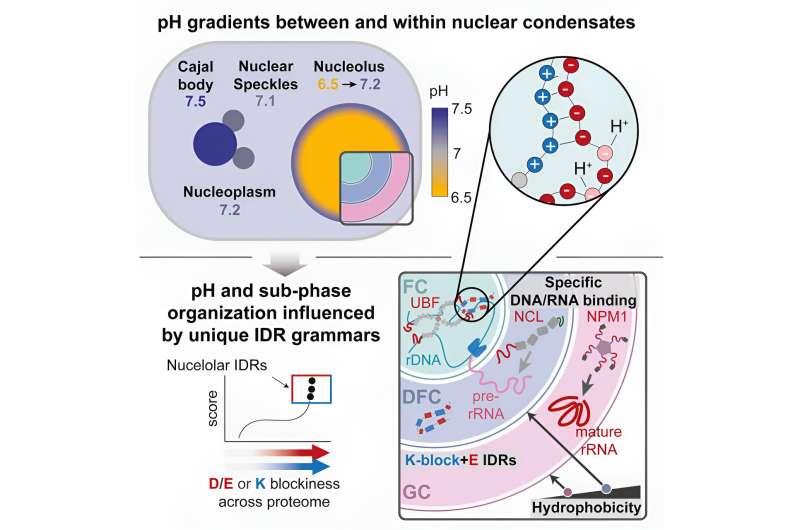This article has been reviewed according to Science X's editorial process and policies. Editors have highlighted the following attributes while ensuring the content's credibility:
fact-checked
peer-reviewed publication
trusted source
proofread
Engineers manage a first: Measuring pH in cell condensates

Scientists trying to understand the physical and chemical properties that govern biomolecular condensates now have a crucial way to measure pH and other emergent properties of these enigmatic, albeit important, cellular compartments.
Condensates are communities of proteins and nucleic acids. They lack a membrane and come together and fall apart as needed. The nucleolus is a prominent condensate in cells. It serves vital roles in cellular physiology and is the site of ribosome production.
Ribosomes are the multi-protein and RNA assemblies where the genetic code is translated to synthesize proteins. Impairment of ribosome production and other nucleolar dysfunctions lie at the heart of cancers, neurodegeneration, and developmental disorders.
In a first for the condensate field, researchers from the lab of Rohit Pappu, the Gene K. Beare Distinguished Professor of biomedical engineering, and colleagues in the Center for Biomolecular Condensates in the McKelvey School of Engineering at Washington University in St. Louis, figured out how nucleolar sub-structures are assembled.
This organization gives rise to unique pH profiles within nucleoli, which they measured and compared with the pH of nearby non-nucleolar condensates, including nuclear speckles and Cajal bodies.
In the study published in Cell, the authors report that the distinct protein compositions of nucleoli give them an acidic character, whereas nuclear speckles have the same pH as the nucleus, and Cajal bodies are more basic.
Building on spatial proteomics data from the lab of Emma Lundberg, associate professor of bioengineering at Stanford University, and novel algorithms developed by Kiersten Ruff, a staff research scientist at McKelvey, and colleagues in the Pappu lab, the team identified unique "molecular grammars" including the presence of proteins with long acidic tracts as a key defining feature of many nucleolar proteins.
This, the team reasoned, must help carry hydrogen protons into nucleoli (pH is the measurement of the activity of protons).
Condensates are like a gathering of people on a convention floor. There are no walls keeping them in place, just sparkling conversations led by a few key individuals—the "scaffolds." The community of molecules that come together enables emergent properties in the condensates, like internal pH in nucleoli.
Condensates form via a process that the team now refers to as condensation. This combines phase separation—think demixing of oil and water—and sticky interactions among molecules that like to bind with one another.
"A combination of specific interactions and distinct solubility profiles defines biomolecules. Condensation involves the totality of these interactions, and this gives rise to what is known as emergent properties," said Matthew King, a postdoctoral fellow in the Pappu lab and lead author of the paper.
The new research provides a starting point for understanding how emergent properties, whereby the whole is greater than the sum of its parts, give rise to condensate-specific "physicochemical barcodes," according to King.
Differentials in pH between condensates and the surrounding nucleoplasm generate gradients, and "a pH gradient generates what is known as a proton motive force," King said.
This proton motive force, measured to be -88 mJ per proton, "might be able to facilitate directional movement of RNA and protein molecules, which is a key first step in enabling ribosomal assembly," King added.
Getting chemical probes to the right place in cells and measuring the condensates required technological innovations that included contributions from McKelvey project partners Michael Vahey, assistant professor of biomedical engineering, and Matthew Lew, associate professor of electrical and systems engineering.
According to Pappu, this work "provides an elegant solution to the challenge that many biochemists see for the condensate concept."
Cellular reactions require specificity. Every biochemical reaction must take place in the right place, at the right time, and must involve specific sets of proteins and nucleic acids.
"Condensates were often criticized as being non-specific blobs," Pappu said.
Thanks to this new research, those blobs clearly have specific physiochemical properties.
"We now have evidence that distinct compositional biases of condensates generate distinct physicochemical environments, and this might provide the basis for biochemical specificity," Pappu noted.
More information: Matthew R. King et al, Macromolecular condensation organizes nucleolar sub-phases to set up a pH gradient, Cell (2024). DOI: 10.1016/j.cell.2024.02.029
Journal information: Cell
Provided by Washington University in St. Louis





















